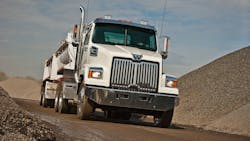Bendix Tech Tips: Protecting wheel-ends in off-highway, severe-duty applications
All trucks get dirty. But some jobs are dirtier than others and require extra care to prevent contamination and corrosion that can affect brake performance and safety. The following tips can provide fleets and drivers with advice on protecting wheel-ends in off-highway and severe-duty applications where dust and dirt can accumulate quickly and damage components.
Chamber checks
“Air chambers have been required on air-braked commercial vehicles in the United States for decades, so the spring brake has been a crucial part of wheel-end safety for a long time now,” said Mark Holley, Bendix director of marketing and customer solutions, Wheel-End. “By design, they help ensure you still have brakes even if you have a wheel-end that’s inoperable. Keeping the spring within the brake chamber intact and corrosion-free is key to maintaining this capability—a broken power spring is the number-one reason for failure, most often caused by contaminants that get into the chamber and weaken the spring.”
It’s a critical enough component that the American Trucking Associations’ Technology & Maintenance Council (TMC) Recommended Practice 604D stresses, “Always replace service or spring brake chambers if there is evidence of significant corrosion damage. Any holes that penetrate through the spring housing or service housing are dangerous and are cause for the chamber to be replaced immediately.”
While standard chambers are manufactured with drain holes to prevent buildup of corrosive moisture inside, there’s an added risk of these holes becoming clogged by dirt or debris on trucks that operate in environments like construction sites, or on vehicles like cement trucks with axles that are regularly exposed to high levels of grit and dust. The same can be said of chambers on the axles of some types of bottom-dump trailers. Protecting the spring brake chamber life in these applications requires a combination of regular cleaning and inspection.
“When the truck is in for regular maintenance or lubrication every 45 to 60 days, use a plastic pin to clear dust from the air holes,” Holley explained. “If they’re blocked, then that spring is going to fail at some point. Then, remove the dust plug so you can use an air hose to clean the chamber. Don’t forget to replace the dust plug afterward. You should also use a pressure washer to clean the exterior, but again–you’ve got to make sure the drain holes are clear first so you don’t trap water in the chamber housing.”
Added protection
There are also specialized parts you can add to in-service vehicles that will enhance protection against contaminants getting where you don’t want them.
If you find you’re replacing spring brakes more often than expected, then consider switching to sealed spring brakes, which are engineered to prevent damaging elements from entering. There are a few different designs on the market: The Bendix EnduraSure-Pro spring brake eliminates the drain holes and integrates a one-way check valve into the dust plug. This check valve allows the spring brake to exhaust air while keeping contaminants out.
“The buildup of contaminants can also affect friction performance and durability, so Bendix also recommends pad shields for air disc brakes and dust shields for drums that go on the inboard side of the brake,” Holley said. “And again, make sure you’re taking a look at these components during regular preventive maintenance.”
In the case of drum brake dust shields, check the mounting bolt torque: If you see egg-shaped holes or dents in the shield, then the bolt has likely been loose for a while and the shield will need to be replaced. Shield damage can also occur if the part is interfering with the drum or brake lining.
“Don’t overlook friction selection in these applications,” said Holley. “High-duty cycle or severe-duty friction is designed to handle heavy loads, higher temperatures, and frequent stops. These frictions will give fleets better performance and longer service life. Bendix offers the BX283 High-Duty Cycle Pad for air disc brake systems and the BA233 friction for drum brakes. Do not select a friction with a higher weight rating than you’re running–assuming it will provide the extra stopping power these applications demand. That’s not the case. Always choose friction for your GAWR,” Holley advised.
Don’t overlook lubrication
Keeping the brakes’ cam tubes and slack adjusters properly greased is also of heightened importance in high dirt/dust environments, according to Kevin Pfost, Bendix technical service coordinator.
“When you force new lubricant in, you’re also purging the old grease, along with any contaminants that have gotten in there,” Pfost said. “And the dustier the environment, the faster that grease loses its ability to protect and lubricate. In a slack adjuster, that’s going to affect your brake stroke and impede stopping performance.”
With a little extra care and the right maintenance and equipment choices, you can protect your trucks and drivers–even when things get dirty.
